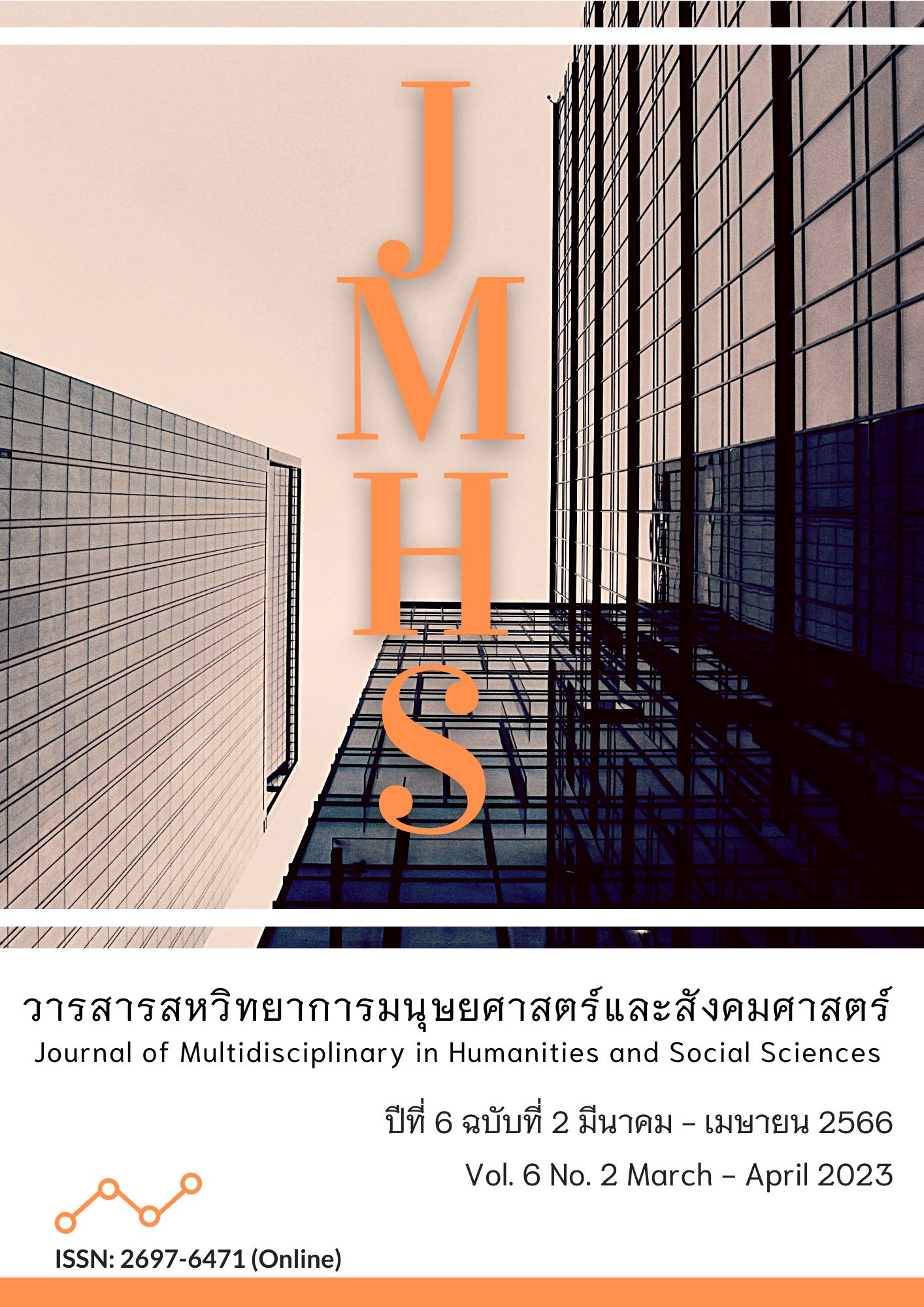Experience in Quality of Life Management Among End-Stage Liver Cancer Patients With Caregivers and Health Personnels at University Hospital
Main Article Content
Abstract
This article aimed to study 1) the necessity related to the quality of life of patients with terminal liver cancer and 2) the experience of managing the quality of life of patients with terminal liver cancer in the university hospital. The design of this research was qualitative. The study model was a phenomenological study area, which was a university hospital. Data were collected through in-depth interviews and participant observation to verify the validity of the data. There were 3 groups of informants: 1) 10 caregivers; 2) 10 patients with terminal liver cancer; and 3) 5 medical personnel using purposive sampling. The research tool was a semi-structured interview (semi-structured) by analyzing the content and writing a descriptive narrative.
The research results were found as follows: 1. Quality of life of patients with terminal liver cancer Caregiver's perspective on life experiences Patients and medical personnel. The definition of quality of life for patients with terminal liver cancer is the same as the quality of life of terminally ill cancer patients: living while sick. face the symptoms of the disease Coping with stress and despair with relatives as caregivers and medical personnel to give advice on palliative treatment and finding the effect caused by illness with liver cancer in the last stage affecting the quality of life during illness in all four aspects, namely physical effects Emotional and psychological effects social impact and spiritual impact; 2. There are various management styles. Medicated symptom management, in large hospitals, especially university hospitals, is managed where morphine is administered. The caregiver manages the symptoms non-drug by playing instrumental music. Patients received stress management and primary social support from their caregivers. A secondary study from a multidisciplinary personnel team found that medical personnel managed bad news communication to patients and caregivers and end-of-life management. to give patients Seeing death as happiness.
Article Details

This work is licensed under a Creative Commons Attribution-NonCommercial-NoDerivatives 4.0 International License.
Views and opinions appearing in the Journal it is the responsibility of the author of the article, and does not constitute the view and responsibility of the editorial team.
References
กองยุทธศาสตร์และแผนงาน, สำนักงานปลัดกระทรวงสาธารณสุข. (2559). สถิติสาธารณสุข พ.ศ. 2559. นนทบุรี: สำนักงานปลัดกระทรวงสาธารณสุข.
จิตชญา บุญนันท์ และ ปรางทิพย์ ฉายพุทธ. (2552). บทบาทพยาบาลในการสื่อสารไม่พึงประสงค์หรือแจ้งข่าวร้ายในผู้ป่วยมะเร็ง. Thai Journal of Nursing Council, 24(3), 7-19. สืบค้นจาก https://he02.tci-thaijo.org/index.php/TJONC/article/view/2572
ชลิยา วามะลุน, มาลี ไชยเสนา และนุสรา ประเสริฐศรี. (2559). ทักษะการดูแลของผู้ดูแลผู้ป่วยมะเร็งระยะสุดท้าย. วารสารการพยาบาล การสาธารณสุขและการศึกษา, 17(1), 40-51. สืบค้นจาก https://he01.tci-thaijo.org/index.php/bcnpy/article/view/71787
นงลักษณ์ สรรสม. (2552) ปัจจัยคัดสรรที่มีความสัมพันธ์กับคุณภาพชีวิตของผู้ป่วยมะเร็งระยสุดท้าย(วิทยานิพนธ์ปริญญามหาบัณฑิต). จุฬาลงกรณ์มหาวิทยาลัย.
นภา ทวียรรยงกุล, สุชิรา ชัยวิบูลย์ธรรม และ บัวหลวง สำแดงฤทธิ์ (2558). ประสบการณ์อาการและการจัดการในผู้ป่วยมะเร็งระยะลุกลามที่ได้รับการดูแลแบบประคับประคอง. Rama Nurs J, 12(1), 82-95.
ประเสริฐ เลิศสงวนสินชัย และคณะ. (2550). การดูแลผู้ป่วยระยะสุดท้าย. กรุงเทพฯ: อักษรสัมพันธ์ (1987) จำกัด.
ปิยะวรรณ โภคพลากรณ์ และคณะ. (2555). เปรียบเทียบวิธีการดูแลและคุณภาพชีวิตของผู้ป่วยมะเร็งระยะลุกลามที่ได้รับการดูแลแบบประคับประคองในสี่ระดับของการดูแลที่แตกต่างกัน. Pacific Rim International Journal of Nursing Research, 16(4), 326-342.
ศรีรัตน์ มากมาย, ฉัตรชัย สิริชยานุกูล, และธราณี สิริชยานุกุล. (2556). อาการที่พบบ่อยและความต้องการของผู้ป่วยมะเร็งระยะลุกลามก่อนได้รับการจำหน่ายจากโรงพยาบาล: กรณีศึกษา ณ โรงพยาบาลแพร่. วารสารโรคมะเร็ง, 33(4), 132-145.
ศุภศิริ เชียงตา, วัลย์ลดา ฉันท์เรืองวณิชย์, อรพรรณ โตสิงห์ และ ภาวิน เกษกุล. (2560). การศึกษาความสัมพันธ์ของความต้องการการดูแลแบบประคับประคองระหว่างผู้ป่วยมะเร็งศีรษะและคอกับผู้ดูแล. วารสารสภาการพยาบาล, 32(2), 31-48. สืบค้นจาก https://he02.tci-thaijo.org/index.php/TJONC/article/view/90466
สุกัญญา วิริยโกศล. (2562). การพัฒนารูปแบบการดูแลผู้ป่วยมะเร็งระยะสุดท้ายแบบประคับประคอง: การดูแลแบบไร้รอยต่อเครือข่ายโรงพยาบาลพระพุทธบาท. วารสารวิชาการสาธารณสุข, 30(6), 1101-1111.
วงจันทร์ เพชรพิเชฐเชียร. (2554). การพยาบาลที่เป็นเลิศในการดูแลผู้ป่วยโรคมะเร็ง. สงขลา: ชานเมืองการพิมพ์.
วริสรา ลุวีระ. (2556). การดูแลสุขภาพของผู้ดูแลผู้ป่วยระยะสุดท้าย. ศรีนครินทร์เวชสาร, 28(2), 266-270.
อภิชัย ลีละสิริ. (2554). การดูแลรักษาผู้ป่วยระยะสุดท้าย. เวชสารการแพทย์ทหารบก, 64(2), 97-102.
อุปทิน รุ่งอุทัยศิริ. (2551). การพัฒนาต้นแบบระบบการดูแลประคับประคองผู้ป่วยระยะสุดท้าย โดยการมีส่วนร่วมของชุมชน อำเภอเสลภูมิ จังหวัดร้อยเอ็ด. วารสารวิจัยระบบสาธารณสุข, 2(2), 1021-1030.
Edwards, B., & Clarke, V. (2004) The Psychological Impact of a Cancer Diagnosis on Families: The Influence of Family Functioning and Patients’ Illness Characteristics on Depression and Anxiety. Psycho-Oncology, 13, 562-576. https://doi.org/10.1002/pon.773
Endler, N. S., Parker, J. D. A., & Summerfeldt, L. J. (1998). Coping with health problems: Developing a reliable and valid multidimensional measure. Psychological Assessment, 10(3), 195-205. https://doi.org/10.1037/1040-3590.10.3.195
Wilson, I.B., & Cleary, P.D. (1995) Linking clinical variables with health-related quality of life: A conceptual model of patient outcomes. JAMA, 273, 59-65. http://dx.doi.org/10.1001/jama.1995.03520250075037


